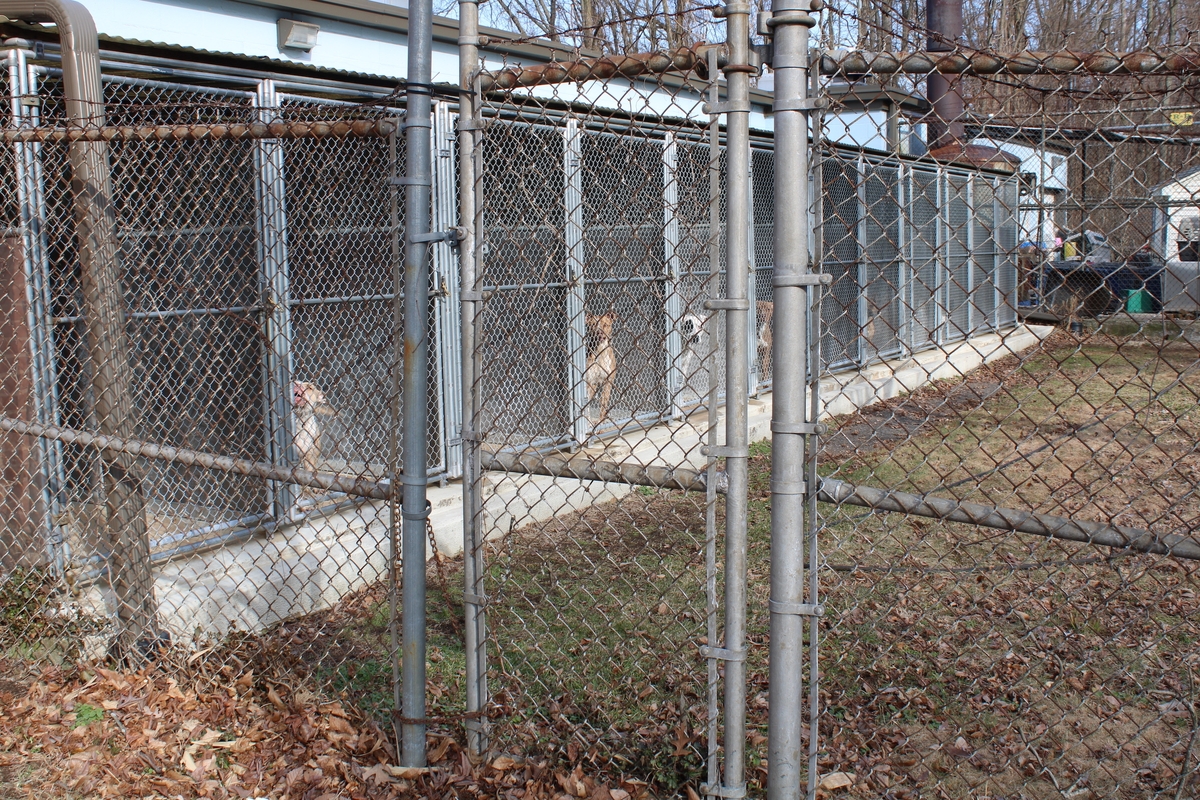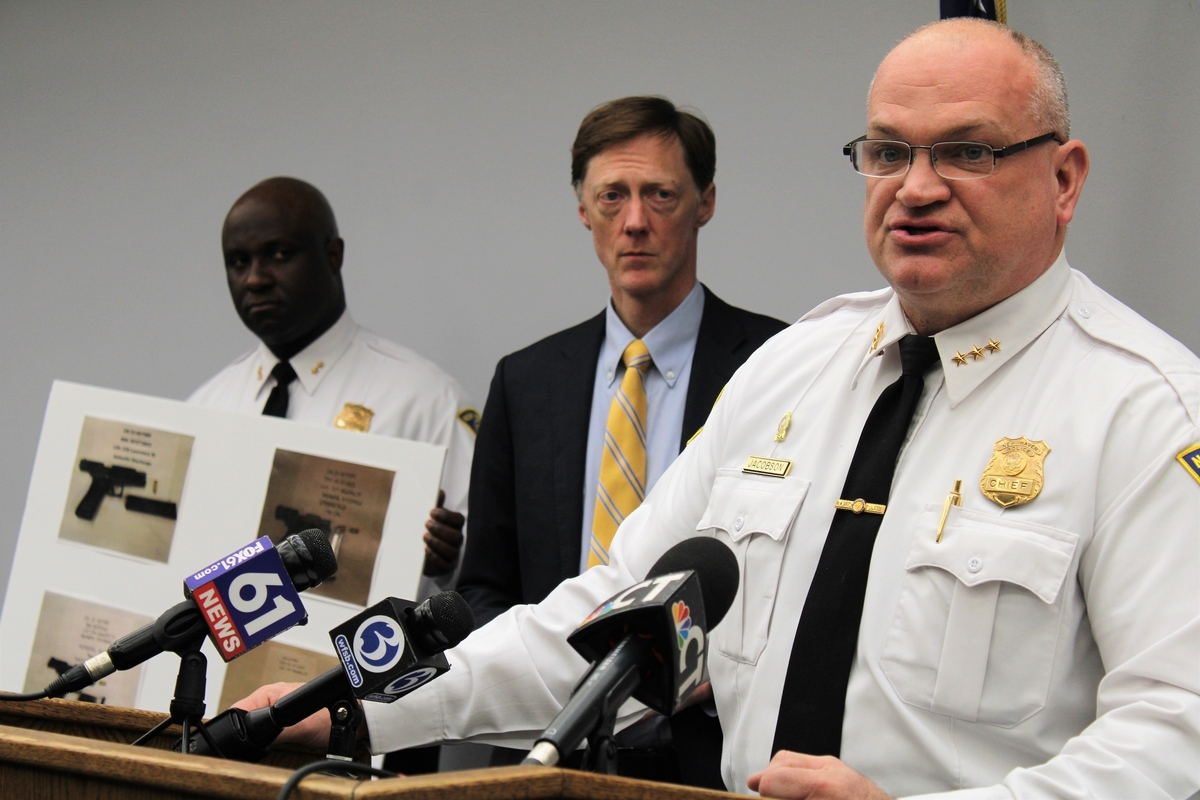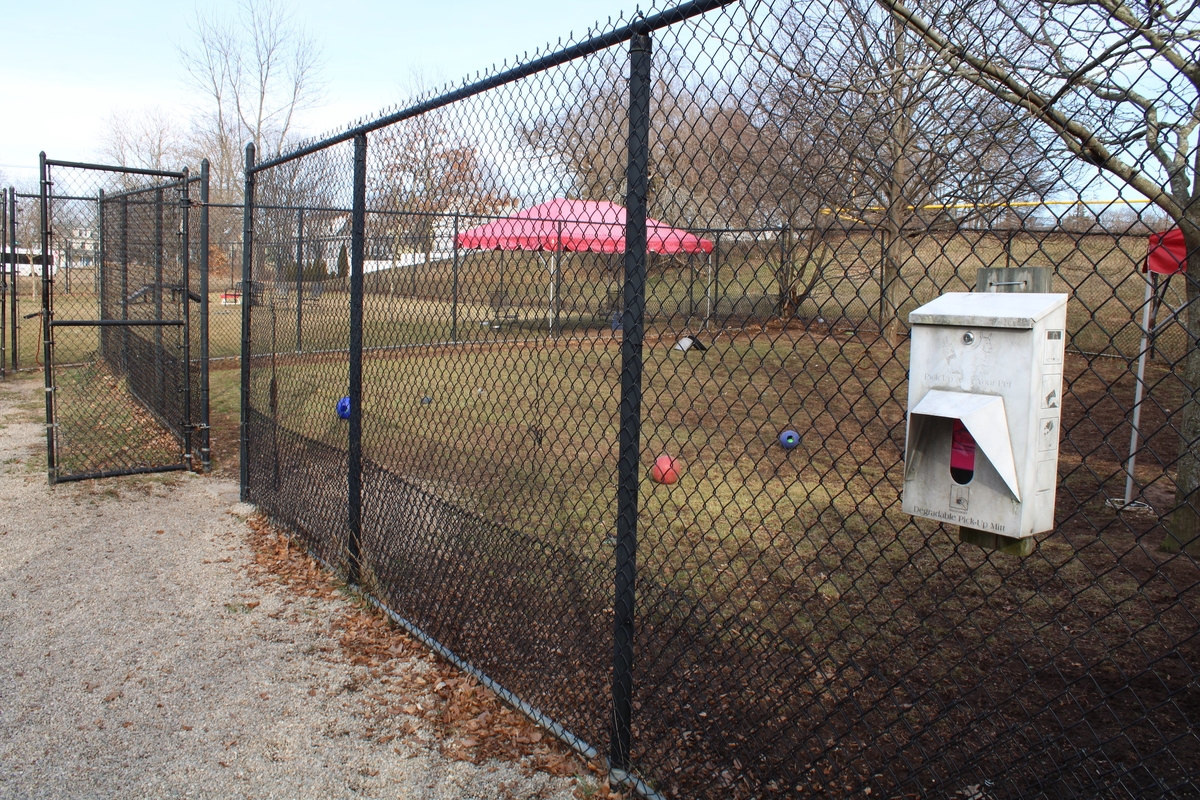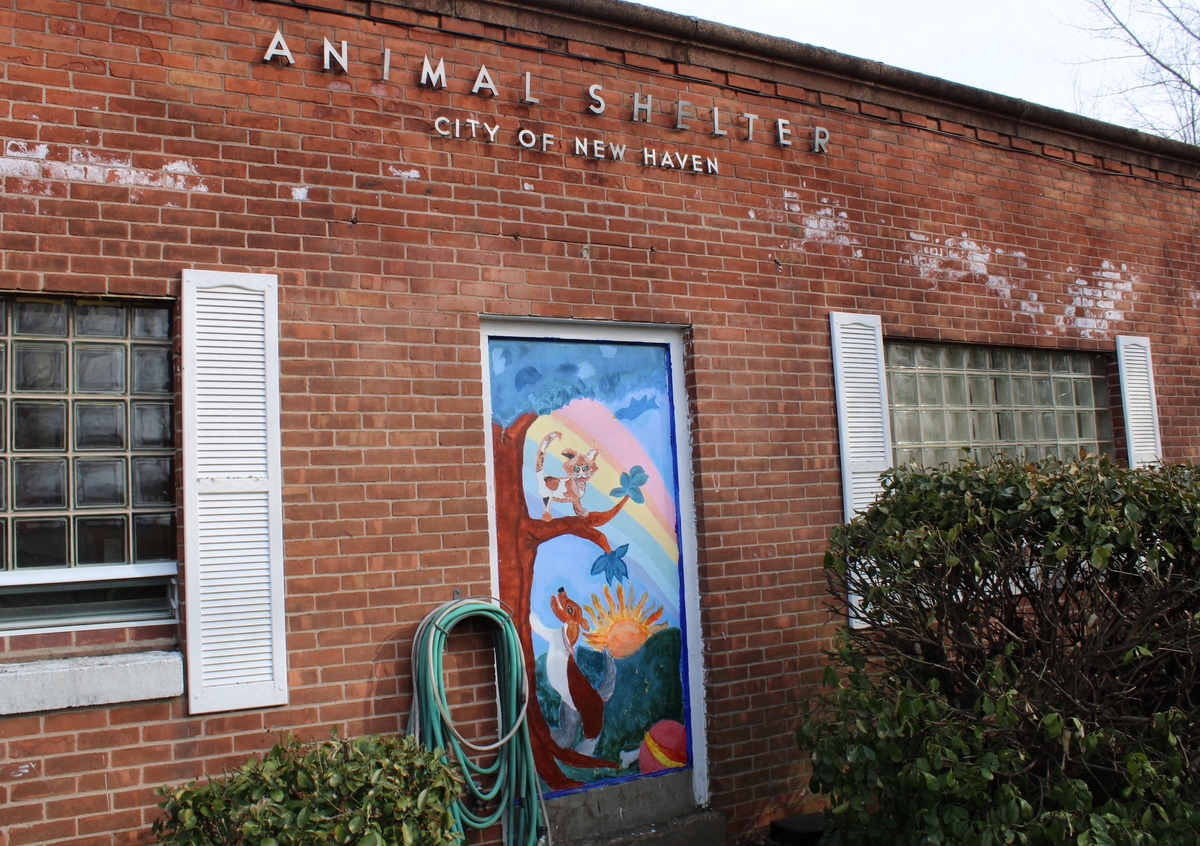
Nora Grace-Flood photo
Remaining pooches at city's under-investigation animal shelter.
A new HVAC system and veterinary care suite are coming to the city’s animal shelter — as ongoing investigations draw attention to the Fournier Street site’s lack of physical space for a growing number of abandoned animals, as well as to a chronic underinvestment in daily operations.
That’s the latest in New Haven’s, and Hamden’s, attempts to control and care for the area’s neglected dogs and cats, a growing issue in the era of post-pandemic pets.
Since those intentions were introduced last March by Hamden Mayor Lauren Garrett, who had said during her 2021 campaign for office that she would name a site for a Hamden shelter by her 100th day on the job, little progress has been made on establishing a revitalized and regionalized facility.
Recently launched and ongoing investigations into New Haven’s treatment of animals, meanwhile, seem to be spurring new improvements and attention to how the city should confront animal control.

Thomas Breen photo
Chief Jacobson (right) with Mayor Elicker (center) at a recent police presser.
The State Department of Agriculture and the New Haven Police Department have both been examining operations at the Fournier Street site since late January following reports of malnourished dogs at the shelter. The DOA did not respond to requests to comment from the Independent by this story’s time of publication. Police Chief Karl Jacobson told the Independent that while both investigations are still underway, city police have already highlighted underlying issues ranging from overcrowding of animals to problematic ventilation to understaffing.
Around 20 animals found by the state to be in poor health conditions have already been transferred to North Haven and Branford animal shelters to receive better care. Jacobson said about 70 pets still remain in New Haven.
Jacobson said he has already replaced Officer Joseph Manganiello, who was the lead officer working on-site at the shelter every day for the past eight years, with a new officer and returned Manganiello to patrol.
“I don’t believe the officer or their supervisor did anything wrong or abused the animals,” Jacobson stated. “But I wanna be sure. I wanna be transparent, I wanna be accountable.”
City officials say they are taking action by responding to overdue capital needs, passing new record keeping policies and putting more paid workers in place to better protect animals. The most immediate and concrete changes to the shelter may be a long list of engineering upgrades to the site, from new flooring to better heat and air conditioning, over the next year.
As for the long haul, both New Haven Mayor Justin Elicker and Hamden Mayor Lauren Garrett have continued to express intent to work together towards regionalization — which would expand not just the footprint of Kroogman but also its resources and capacities.
However, little progress has been made on that undertaking and no clear plan of action exists to help actualize it.
“There’s a reason this doesn’t happen more frequently,” Elicker said of regionalization. “We’ve had conversations with Hamden and are starting to work through how a partnership might work… we’re cautiously optimistic.”
“It isn’t just about a building,” he continued. “I think oftentimes the most challenging things are long-term operational and staffing costs.”
This new state investigation comes several months after the city police department conducted its own internal investigation of the shelter following an anonymous complaint of animal neglect and faulty record keeping.
Investigations, Investments

The state first became involved in New Haven’s shelter operations on Jan. 25, after following up on photos submitted to the Department of Agriculture of “malnourished dogs” on site, according to Chief Jacobson.
Jacobson said he launched a local internal affairs investigation shortly after the state did so in order to “get to the bottom of what really happened” concerning the dogs’ welfare.
While both investigations are ongoing and targeted towards treatment of the affected dogs, Jacobson said that the state review has already shone light on multiple ways the shelter should change in order to provide what is considered a sufficient level of care for its animal clients.
Variables such as the chemicals used to clean the pets’ cages, a lack of open space and cramped crates, poor ventilation, and problematic record keeping could have all contributed to a high number of sick pets.
No definite conclusions have been reached concerning which practices have caused which issues. For example, Jacobson said that a pattern of rashes had been uncovered across a group of dogs which could have been caused by inadequate cleaning of crates, utilization of overly abrasive cleaning products, or faulty ventilation.
The ostensibly more pressing issue driving the investigation — dogs that continued to lose weight upon arrival at the shelter — could also be due to anything from the animals being irreconcilably ill upon arrival to overcrowding-induced stress to failure of staff to feed the animals regularly.
The scopes of both investigations are broad and overarching, triggered by the starved dogs and uncovering new dilemmas as they progress.
Jacobson said the “root cause” of the shelters’ current problems were the high number of pet adoptions during the pandemic and the disproportionate rate of abandonment when owners began returning to pre-pandemic lifestyles, like working from an office rather than from home. “After the pandemic, everyone gave their dogs back or let them out — and we went from capacity to way over capacity.”
He said that over the past couple of years, the number of animals under the shelter’s oversight has increased by roughly a third. On a given week, the shelter may be charged with caring for up to 100 unhoused pets.
“It’s a crazy amount of animals!” he exclaimed.

Some of the space provided for volunteers to play with dogs outside the shelter.
Jacobson has already proposed and is reportedly starting to implement a slate of changes with the hopes of improving conditions at the shelter.
Capital improvements in the works include $700,000 worth of upgrades scheduled for completion over the next 12 months. Those include implementing a new HVAC system, epoxy floors and finishes, a veterinary care suite, noise mitigation strategies, dividers in the back courtyard and kennels to grant animals more privacy and comfort, and added storage space. Those upgrades will be funded by state aid sent to New Haven last summer.
“Safe areas for the animals to exercise, quarantine and isolate could all be better,” Jacobson said.
The mayor’s proposed budget also includes salaries for two additional animal control officers.
Before the investigations, Jacobson said that Officer Manganiello typically worked with just two-part time employees. Moving forward, he is looking to increase the number of staff to include four part-time civilian employees, two-part time officers, and the new full-time officer. In addition, a new supervisor from the police department will check in on the shelter daily, where one used to observe operations on a weekly basis.
Heeding state advice, he is also requiring that shelter workers photograph each animal upon arrival and on a routine basis thereafter to allow for observation of the animals’ well-being.
Jacobson said he did not know the timeline for when either investigation would be complete. “In New Haven, it’s gonna take a while because my Internal Affairs unit is working on the Randy Cox case,” he said, referring to the paralysis of a New Havener last summer while in the custody of city cops.
Renovations OK'd, Regionalization Stalled

New Haven’s shelter woes collided with the one-year anniversary of plans pressed by both Mayor Elicker and Mayor Garrett to join forces to build a bigger and better facility.
Recent phone conversations with both leaders underscored a commitment by both municipalities to follow through on the soft plan — as well as the fact that little has been done so far to bring that commitment to fruition.
“Right now we are still looking into the costs of renovations and expansion of the animal shelter,” Garrett told the Independent in a Friday phone call. “There were some initial cost estimates that were a little high. Continuing on the path that we’re on is really dependent on what the budget is like,” she said. She also shared the town has yet to have conversations about what an appropriate amount to expend on such a facility would be.
Garrett said ensuring that Hamden has its own shelter is “important because it’s something that the community has really asked for and I’m there to serve the community.” Read more here about the public pressure imposed by Hamdenites during the last mayoral race to get the town’s next leader to establish an animal shelter.
Asked why she believed partnering with New Haven was the right fit for solving the town’s animal control issues, she said “anytime we’re able to regionalize some of our work, some of our assets, it can really help us to save money.”
Garrett said Town Engineer Stephen White would be better equipped to answer questions concerning costs and planning for a shelter.
“I’m not even sure where we are on that project right now,” White told the Independent. “We had some estimates we were putting together… but I don’t think we’re in a place where it would be a good idea to put numbers on it. Honestly, I haven’t spent a lot of time on it lately.”
He said the original cost estimates “kind of put brakes” on any substantive project development. “If we couldn’t bring that number down, we weren’t sure how to get things moving.”
New Haven City Engineer Giovanni Zinn agreed that so far the city has only done baseline research into how many dollars per square foot might be expected for a bolstered shelter. “You can’t put pen to paper unless you know how the facility would operate,” he said. “But it’s an expensive type of facility to construct on a per unit basis because it’s a specialized building — it’s expensive and there’s no two ways about it.”
He said that the two municipalities would have to work out the expected operations of a shared shelter before a design of the building itself could be drafted or estimated costs crunched.
Mayor Elicker said that while New Haven has “had a number of conversations with Hamden” about the shelter, “anytime municipalities try to reach an allied service, it’s challenging.”
“There’s a reason this doesn’t happen more frequently,” he said of regionalization. “There are challenges around the operations and there are funding questions, labor questions.”
“The benefit of having a partnership with another town is simply more shared resources,” he said. “One of the challenges we’ve had is primarily around staffing: our ability to have enough people on site to ensure that the animals are walked and given attention, which is important to their well-being and maintaining stress levels.
“The priority should be ensuring that animals stay there for as short a time as possible because we wanna find them a home.”
Keep The Kittens, Spare The Cops?
Beyond a couple extra wings to house more animals on Fournier Street down the line, Karl Jacobson had one suggestion for how to alter animal shelter operations in the future: Take cops out of the equation.
“Here we are where we don’t have enough officers for the city as it is,” he said, and the city is upping the number of cops hired to oversee the animal shelter. “I think it’s important to look at ways we can have civilians at the shelter so officers do what they’re supposed to be doing.”
He said animal control is often linked to cops because officers are called to use their weapons to euthanize wild animals like deer hit by cars. But guns are, obviously, not the select choice for euthanizing shelter dogs and cats.
Jacobson noted that Manganiello’s eight-year stint at the shelter was also problematic. “I like to see officers in a given position for about three to four years. If they go any further, they’re losing their skills” to become a sergeant or move up further in the ranks. Manganiello has since returned to working in the capacity of a patrol officer.
Elicker said that full civilianization of animal shelter staff is “also a question we’d need to explore.”
The bottom line, he said, is that “the animal shelter should be operated in the most humane way possible,” and that renovations are moving forward on Fournier — and those “renovations don’t necessarily impact a future expansion.”









"Before the investigations, Jacobson said that Officer Manganiello typically worked with just two-part time employees. Moving forward, he is looking to increase the number of staff to include four part-time civilian employees, two-part time officers, and the new full-time officer. In addition, a new supervisor from the police department will check in on the shelter daily, where one used to observe operations on a weekly basis."
First of all, Jacobson's information is not even correct because he does not have clue as to what happens in the Animal Shelter. Officer Manganiello had 4 full-time employees however 1 is out on injury leave & 1 position is vacant. The other two positions that actually showed up to work with Officer Manganiello are full-time & often work OT.
Secondly, It sounds like Officer Manganiello was left alone to manage the shelter for 8 years without supervision from his superiors or proper staffing. Wasn't Capt. Dell assigned as the supervisor of the shelter back in January. Shouldn't she have known if animals were experiencing kennel stress & losing weight? Shouldn't she have addressed the staffing issues well before now? It is a known fact that Officer Manganiello requested additional staffing multiple times, & the Chief refused to provide the help. Now they got rid of Officer Manganiello because of their lack of leadership. Something doesn't sound right! I am unsure if Officer Manganiello is being used as their fall guy or if this is a political ploy involving the merger with Hamden.
Officer Manganiello has done one hell of a job running that shelter for the last 8 years. By the way, the money being used for the new HVAC system & veterinary care suite was a donation spearheaded by Officer Manganiello. Officer Manganiello had many connections & good relationships with the community, volunteer organizations, & donors. He will truly be missed. It is a shame what the Chief is doing to his outstanding reputation. We will miss you, Officer Joe